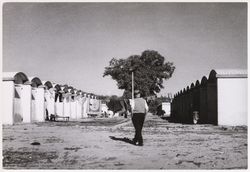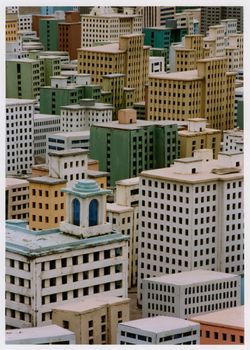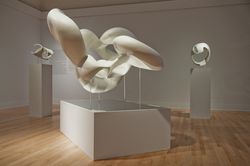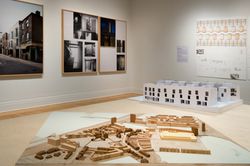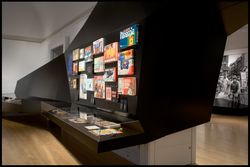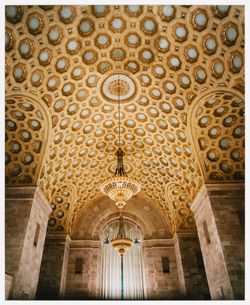archives
Niveau de description archivistique:
Fonds
Fonds Pierre Jeanneret
AP156
Résumé:
Le Fonds Pierre Jeanneret documente la pratique professionnelle et la vie personnelle de l'architect Pierre Jeanneret de ses études et ses projets professionels en Europe à ses projets architecturaux à Chandigarh, en Inde. Les documents du Fonds consistent en des photographies, des dessins et des documents textuels relatifs à plus de 100 projets, principalement son travail pour le projet de la nouvelle ville de Chandigarh, en Inde, en 1951 à 1965. *** The Pierre Jeanneret fonds documents the professional practice and the personal life of architect Pierre Jeanneret from student and professional work in Europe to architectural projects in Chandigarh, India. The documents in the fonds consist of photographs, drawings and textual records relating to over 100 projects, predominantly his work for the project of the new city of Chandigarh, in India, in 1951 to 1965.
1870s-2011
Fonds Pierre Jeanneret
Actions:
AP156
Résumé:
Le Fonds Pierre Jeanneret documente la pratique professionnelle et la vie personnelle de l'architect Pierre Jeanneret de ses études et ses projets professionels en Europe à ses projets architecturaux à Chandigarh, en Inde. Les documents du Fonds consistent en des photographies, des dessins et des documents textuels relatifs à plus de 100 projets, principalement son travail pour le projet de la nouvelle ville de Chandigarh, en Inde, en 1951 à 1965. *** The Pierre Jeanneret fonds documents the professional practice and the personal life of architect Pierre Jeanneret from student and professional work in Europe to architectural projects in Chandigarh, India. The documents in the fonds consist of photographs, drawings and textual records relating to over 100 projects, predominantly his work for the project of the new city of Chandigarh, in India, in 1951 to 1965.
archives
Niveau de description archivistique:
Fonds
1870s-2011
Farhan Karim, chercheur en résidence 2016, présente ses recherches : Dans l’évolution récente de l’histoire de l’architecture, l’engagement d’architectes occidentaux auprès des nations postcoloniales émergentes a fait l’objet d’une relecture dans une perspective géopolitique plus vaste de décolonisation et de guerre froide planétaire. Une telle analyse n’est certes pas(...)
Maison Shaughnessy
7 juillet 2016, 18h
Séminaire de chercheur en résidence : Farhan Karim
Actions:
Description:
Farhan Karim, chercheur en résidence 2016, présente ses recherches : Dans l’évolution récente de l’histoire de l’architecture, l’engagement d’architectes occidentaux auprès des nations postcoloniales émergentes a fait l’objet d’une relecture dans une perspective géopolitique plus vaste de décolonisation et de guerre froide planétaire. Une telle analyse n’est certes pas(...)
Maison Shaughnessy
Théâtre Paul-Desmarais
27 septembre 2007
Théâtre Paul-Desmarais
Autres odyssées de l’espace expose trois perspectives sur une aventure entamée il y a 40 ans, après la mission lunaire de 1969. Présentant les travaux des architectes Greg Lynn, Michael Maltzan et Alessandro Poli, Autres odyssées de l’espace se tient à un moment où l’exploration spatiale fait l’objet d’un engouement renouvelé, mais aussi de questionnements quant à sa(...)
Salles principales
8 avril 2010 au 19 septembre 2010
Autres odyssées de l’espace : Greg Lynn, Michael Maltzan, Alessandro Poli
Actions:
Description:
Autres odyssées de l’espace expose trois perspectives sur une aventure entamée il y a 40 ans, après la mission lunaire de 1969. Présentant les travaux des architectes Greg Lynn, Michael Maltzan et Alessandro Poli, Autres odyssées de l’espace se tient à un moment où l’exploration spatiale fait l’objet d’un engouement renouvelé, mais aussi de questionnements quant à sa(...)
Salles principales
Projet
Inter-Action Centre
AP144.S2.D82
Description:
File documents Inter-Action Centre, a completed project for a community centre commissioned by Ed Berman and the Inter-Action Trust, for a disused site at Talacre Public Open Space in Kentish Town, Camden, London. The construction was divided into two phases. Foundations, steel frame and trusses were constructed first and could be used for open-air community events while funds were being raised for the second phase. Phase II included cladding, fittings, finishes, services prefabricated units, and log cabins. The building was intended as a flexible short life-span building in which the interior spaces would be independent of the roof and exterior walls. Functional areas suggested by Cedric Price include: assembly halls, classrooms, rehearsal rooms, studios, areas for performance, media resources, lounging and dining, and a gym and a nursery. Cedric Price had been engaged by the concepts of flexible architecture, indeterminacy, impermanence, and the fusion of information technology, entertainment, and educational activities in earlier unrealized projects such as Fun Palace (AP144.S2.D46) and Oxford Corner House (AP144.S2.D59). Existing conditions drawings include photographs of the site; reprographic copies of electrical and drainage systems; ordinance surveys of Kentish Town; and landscape and playground layout. Conceptual drawings include sketches of overall massing; diagrammatic plans; drawings and diagrams of site conditions; notes for the structural framework; rendered interior elevations; plans showing impact of site context on building design; diagrammatic sketches of relationship between functional requirements and structural form. Schematic drawings include diagrammatic plans; sections of structural system and exterior wall; cladding details; and axonometric views of supports. Design development drawings and working drawings include plans, elevations, sections, details and axonometric views. Presentation drawings include watercolours and other renderings; reprographic copies, possibly for publication; and perspectives drawings. Some material from this file was published in "Inter-action Centre." 'RIBA Journal'. (November 1977), 458-465; "Intervista A Cedric Price: London Interaction Centre." 'Domus'. (April 1978), 17-21; "Kentish Town West Amalgam, London." 'Architectural Record'. (January 1973), 19; Lyall, Sutherland. 'The State of British Architecture'. (London: Architectural Press, 1980), 107-109; 130 and 'Cedric Price-Works II' (London: Architectural Press, 1984), 54, 62-63. Material in this file was produced between 1964 and 1992, but predominantly between 1970 and 1981. File contains technical drawings that are attributed to the following consultants, contractors, and manufacturers: Coseley Buildings Ltd; H.G. Deacon Ltd; Kayanson Engineers; H.J. Knights & Co. Ltd; Woodcemair; Metal Sections Ltd; Spaceway; Gascoigne, Gush & Dent (Engineering Ltd); UBM Engineering; J. Murphy & Sons Ltd; Maurice Pickering Associates, Architects & Landscape Consultants; David Lee Architect & Landscape Architect; J. Starkie Gardner Ltd; Dibben Structural Engineers; Zisman, Bowyer & Partners; Felix J. Samuely and Partners; Ruberoid Contracts Ltd; Whitbread London Limited; and Portakabin. Paul Hyett and Will Alsop were Cedric Price's main assistants for this project. 'Inter-Action Trust Limited', 'Inter-Action Centre', and 'Talacre Centre Limited' appear as the client(s) at various stages of this project. File contains cartographic materials, conceptual drawings, consultant drawings, design development drawings, models, panels, photographic materials, presentation drawings, an illustration, textual records, and working drawings.
1964-1992, predominant 1970-1981
Inter-Action Centre
Actions:
AP144.S2.D82
Description:
File documents Inter-Action Centre, a completed project for a community centre commissioned by Ed Berman and the Inter-Action Trust, for a disused site at Talacre Public Open Space in Kentish Town, Camden, London. The construction was divided into two phases. Foundations, steel frame and trusses were constructed first and could be used for open-air community events while funds were being raised for the second phase. Phase II included cladding, fittings, finishes, services prefabricated units, and log cabins. The building was intended as a flexible short life-span building in which the interior spaces would be independent of the roof and exterior walls. Functional areas suggested by Cedric Price include: assembly halls, classrooms, rehearsal rooms, studios, areas for performance, media resources, lounging and dining, and a gym and a nursery. Cedric Price had been engaged by the concepts of flexible architecture, indeterminacy, impermanence, and the fusion of information technology, entertainment, and educational activities in earlier unrealized projects such as Fun Palace (AP144.S2.D46) and Oxford Corner House (AP144.S2.D59). Existing conditions drawings include photographs of the site; reprographic copies of electrical and drainage systems; ordinance surveys of Kentish Town; and landscape and playground layout. Conceptual drawings include sketches of overall massing; diagrammatic plans; drawings and diagrams of site conditions; notes for the structural framework; rendered interior elevations; plans showing impact of site context on building design; diagrammatic sketches of relationship between functional requirements and structural form. Schematic drawings include diagrammatic plans; sections of structural system and exterior wall; cladding details; and axonometric views of supports. Design development drawings and working drawings include plans, elevations, sections, details and axonometric views. Presentation drawings include watercolours and other renderings; reprographic copies, possibly for publication; and perspectives drawings. Some material from this file was published in "Inter-action Centre." 'RIBA Journal'. (November 1977), 458-465; "Intervista A Cedric Price: London Interaction Centre." 'Domus'. (April 1978), 17-21; "Kentish Town West Amalgam, London." 'Architectural Record'. (January 1973), 19; Lyall, Sutherland. 'The State of British Architecture'. (London: Architectural Press, 1980), 107-109; 130 and 'Cedric Price-Works II' (London: Architectural Press, 1984), 54, 62-63. Material in this file was produced between 1964 and 1992, but predominantly between 1970 and 1981. File contains technical drawings that are attributed to the following consultants, contractors, and manufacturers: Coseley Buildings Ltd; H.G. Deacon Ltd; Kayanson Engineers; H.J. Knights & Co. Ltd; Woodcemair; Metal Sections Ltd; Spaceway; Gascoigne, Gush & Dent (Engineering Ltd); UBM Engineering; J. Murphy & Sons Ltd; Maurice Pickering Associates, Architects & Landscape Consultants; David Lee Architect & Landscape Architect; J. Starkie Gardner Ltd; Dibben Structural Engineers; Zisman, Bowyer & Partners; Felix J. Samuely and Partners; Ruberoid Contracts Ltd; Whitbread London Limited; and Portakabin. Paul Hyett and Will Alsop were Cedric Price's main assistants for this project. 'Inter-Action Trust Limited', 'Inter-Action Centre', and 'Talacre Centre Limited' appear as the client(s) at various stages of this project. File contains cartographic materials, conceptual drawings, consultant drawings, design development drawings, models, panels, photographic materials, presentation drawings, an illustration, textual records, and working drawings.
File 82
1964-1992, predominant 1970-1981
recherche
Thème : Le phénomène de changements de paradigmes en architecture depuis l’Antiquité : Brigitte Desrochers, Musée des Beaux-Arts du Canada, Ottawa, Canada Sujet : Au-delà du style. Naissance du classicisme structurel dans les ruines de Pompei Joseph Disponzio, Graduate School of Design, Harvard University, Cambridge, États-Unis Sujet : Jean-Marie Morel and the Invention(...)
septembre 2001 au août 2002
Chercheurs en résidence 2001-2002
Actions:
Description:
Thème : Le phénomène de changements de paradigmes en architecture depuis l’Antiquité : Brigitte Desrochers, Musée des Beaux-Arts du Canada, Ottawa, Canada Sujet : Au-delà du style. Naissance du classicisme structurel dans les ruines de Pompei Joseph Disponzio, Graduate School of Design, Harvard University, Cambridge, États-Unis Sujet : Jean-Marie Morel and the Invention(...)
recherche
septembre 2001 au
août 2002
Cette exposition se consacre aux projets architecturaux récents de Stephen Taylor à Londres et de Ryue Nishizawa à Tokyo, qui proposent de nouvelles approches de la vie en milieu urbain. Perspectives de vie à Londres et à Tokyo imaginées par Stephen Taylor et Ryue Nishizawa marque la première présentation en Amérique du Nord des projets résidentiels de Taylor et Nishizawa(...)
Salles principales
14 mai 2008 au 26 octobre 2008
Perspectives de vie à Londres et à Tokyo imaginées par Stephen Taylor et Ryue Nishizawa
Actions:
Description:
Cette exposition se consacre aux projets architecturaux récents de Stephen Taylor à Londres et de Ryue Nishizawa à Tokyo, qui proposent de nouvelles approches de la vie en milieu urbain. Perspectives de vie à Londres et à Tokyo imaginées par Stephen Taylor et Ryue Nishizawa marque la première présentation en Amérique du Nord des projets résidentiels de Taylor et Nishizawa(...)
Salles principales
archives
Niveau de description archivistique:
Fonds
Bernard Tschumi fonds
AP214
Résumé:
The Bernard Tschumi fonds, dating from approximately 1965-2015, documents the professional activities of Bernard Tschumi including Tschumi’s career in academia and his professional practice as an architect through approximately 75 projects dating from the late 1980s to 2012.
circa 1964-2015
Bernard Tschumi fonds
Actions:
AP214
Résumé:
The Bernard Tschumi fonds, dating from approximately 1965-2015, documents the professional activities of Bernard Tschumi including Tschumi’s career in academia and his professional practice as an architect through approximately 75 projects dating from the late 1980s to 2012.
archives
Niveau de description archivistique:
Fonds
circa 1964-2015
1973 : Désolé, plus d’essence analyse l’innovation architecturale à laquelle a donné naissance la crise énergétique de 1973, alors que la valeur du baril de pétrole augmentait de façon exponentielle, donnant lieu à des bouleversements économiques, politiques et sociaux dans de nombreux pays. Présentant plus de 350 objets – dessins d’architecture, photographies,(...)
Salles principales Mot(s)-clé(s):
1973, désolé plus d'essence, crise du pétrole, énergie, environnement
7 novembre 2007 au 20 avril 2008
1973 : désolé, plus d’essence
Actions:
Description:
1973 : Désolé, plus d’essence analyse l’innovation architecturale à laquelle a donné naissance la crise énergétique de 1973, alors que la valeur du baril de pétrole augmentait de façon exponentielle, donnant lieu à des bouleversements économiques, politiques et sociaux dans de nombreux pays. Présentant plus de 350 objets – dessins d’architecture, photographies,(...)
Salles principales Mot(s)-clé(s):
1973, désolé plus d'essence, crise du pétrole, énergie, environnement
L’or et la pierre: un regard critique sur l’architecture des banques traite de l’histoire et de l’incidence culturelle de l’architecture des banques, considérées comme typologies en soi et non dans le cadre de l’œuvre d’un architecte ou d’une agence d’architectes. Contraires aux idées reçues voulant qu’elles aient un vocabulaire architectural répétitif et incarnent un(...)
Salles principales
14 novembre 1990 au 24 février 1991
L'or et la pierre : un regard critique sur l'architecture des banques
Actions:
Description:
L’or et la pierre: un regard critique sur l’architecture des banques traite de l’histoire et de l’incidence culturelle de l’architecture des banques, considérées comme typologies en soi et non dans le cadre de l’œuvre d’un architecte ou d’une agence d’architectes. Contraires aux idées reçues voulant qu’elles aient un vocabulaire architectural répétitif et incarnent un(...)
Salles principales
